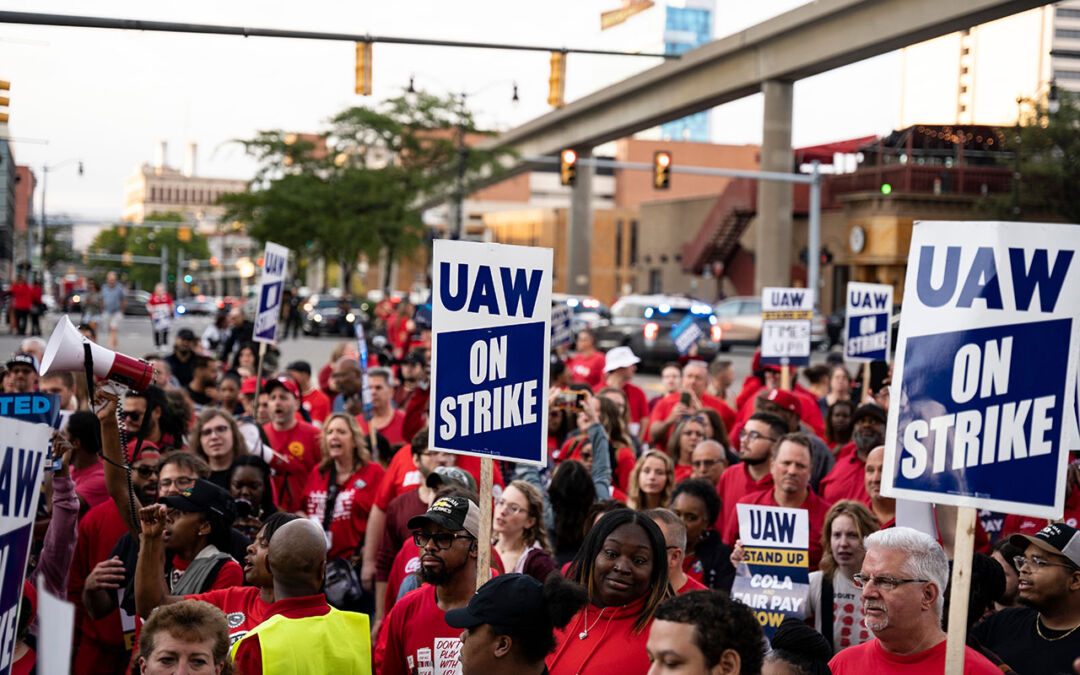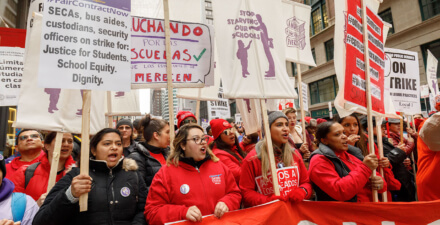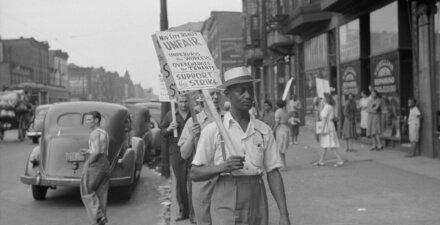What recent research says about the benefits of labor strikes and growing worker power for broader U.S. economic growth

Labor organizing and strikes are experiencing a resurgence in the United States. Before this year’s bevy of labor actions—including Hollywood strikes, autoworker walk-outs, healthcare labor stoppages, and more—2022 and 2021 both also experienced an almost 50 percent increase in labor organizing activity. Workers are demanding higher pay and better working conditions amid a labor market environment that affords workers increased bargaining power, as well as high public support for unions and strikes.
What does the research say about the impact of unionization and worker strikes in the United States? Aside from well-documented benefits that are associated with unions—from increased job security and better healthcare and retirement benefits to more widespread access to paid leave and higher pay—there are other aspects of unionization and heightened worker power that may be less widely discussed. These benefits extend to union members and nonunion workers, entire communities, and the U.S. economy more broadly.
A few cases in point:
- An Equitable Growth-published report by Adam Dean of George Washington University, Jamie McCallum of Middlebury College, and Atheendar Vankataramani of the University of Pennsylvania finds that unions improve worker safety and lower health inequality. They study the spread of COVID-19 in unionized and nonunionized nursing homes in the United States and find that those that were unionized registered better outcomes in terms of COVID-19 transmission and death rates among both residents and workers of nursing homes. The co-authors also find additional health benefits of unions in workplaces with greater percentages of Black workers, helping to mitigate racial health inequity in the United States.
- The Economic Policy Institute finds that Black and Hispanic unionized workers have a higher union wage premium—the increase in earnings that accrues to union members, compared to nonunion workers—than their White counterparts, shrinking the racial wage gap. The think tank also finds that union members, especially Black and Hispanic workers, tend to have higher median levels of wealth than nonunion households, reducing racial economic inequality in the United States along a second dimension.
- A 2021 study by Paul Frymer of Princeton University and Jacob Grumbach of the University of Washington finds that unions temper racial resentment and boost racial solidarity. The co-authors compare views on policies such as affirmative action and other programs that benefit Black Americans among White workers who are unionized and those who are not, finding higher levels of support among the union set. Further, they find that when White workers gain union membership, their levels of racial resentment fall.
- Recent research from Carlos Fernando Avenancio-León at the University of California, San Diego, Alessio Piccolo at Indiana University Bloomington, and Roberto Pinto at Lancaster University shows that unions can improve overall financial stability in the economy by encouraging firms to make less risky borrowing decisions. This further reduces the risk of unemployment for both union workers and the broader workforce. The co-authors also find that firms in states with anti-union right-to-work laws are more prone to riskier borrowing practices, reducing financial stability and increasing the risk of unemployment.
- A study from University of Illinois at Urbana-Champaign’s Marc Doussard and Ahmad Gamal suggests that unions are a bulwark against wage theft. The authors find that states with higher rates of union membership are more likely to pass laws against wage theft, which tends to affect low-wage workers, workers of color, women workers, and non-U.S. citizen workers more than their White, citizen, and male peers.
- A set of two 2021 working papers by economist David Howell explores the possibility that stagnant wages in the United States could be attributed to decades of public policies that lowered labor standards and weakened worker power rather than to globalization, market conditions, or technological advances. By comparing the United States to peer economies, Howell shows that strong unions and worker power can protect workers from wage inequality and other negative economic trends.
It’s still too early to tell what the results of the past few years of increased labor activity will be, but the early indications from several of the recent strikes—and even in some cases simply threats of strikes—seem to back up what the literature says about unions and worker power. When unions are strong and workers can bargain over wages, benefits, and other working conditions, workers come out on top and the benefits are felt across the U.S. economy.



